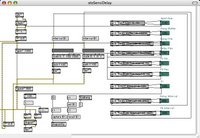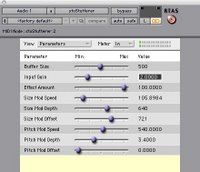You can download the plugins that i have been mucking around with here:
http://www.milkcrate.com.au/_other/plugins/
Using these plugins requires the Pluggo runtime, which can be obtained here: http://www.cycling74.com/downloads/pluggo. The Pluggo runtime is freeware. The plugins will work as RTAS, VST and AU format plugins.
Future plugins will also be added to these directories.
Showing posts with label plugins. Show all posts
Showing posts with label plugins. Show all posts
Monday, November 19, 2007
Demo video of 3 homemade plugins
http://www.youtube.com/watch?v=0spvCtwzh_I
The three plugins are:
Keep in mind that they are all sample / track manipulation plugins and are not synthesis plugins - ie. they are not purely virtual instruments but they are controlled with MIDI data.
The three plugins are:
Keep in mind that they are all sample / track manipulation plugins and are not synthesis plugins - ie. they are not purely virtual instruments but they are controlled with MIDI data.
stoUnion
Yet another plugin. This one takes very small snippets from an incoming audio stream and uses these snippets to construct waveforms that are played back. The input buffers are updated at a random interval with a minimum of 10ms and a maximum of between 100ms and 1000ms as the user dictates. The plugin is polyphonic and each voice has a separate random factor associated with it (ie. the output audio waveforms will not be updated at the same time for all voices).




Sunday, November 18, 2007
stoShadow and stoRep
Two new plugins.
stoRep: Polyphonic, looping audio buffer whose looping points are modulated by the amplitude of a control signal.



stoShadow: Uses the waveform from one audio track as an amplitude modulator for the carrier waveform of a second audio track. This plugin comes in two parts; a transmitter and a receiver.


stoRep: Polyphonic, looping audio buffer whose looping points are modulated by the amplitude of a control signal.



stoShadow: Uses the waveform from one audio track as an amplitude modulator for the carrier waveform of a second audio track. This plugin comes in two parts; a transmitter and a receiver.


Friday, November 16, 2007
Demo video of 4 homemade plugins
URL: http://youtube.com/watch?v=L6zvR7RukUA
Length: 1:21
A simple demo of four homemade plugins for ProTools. All of the sound that you hear is generated from these four plugins (besides two simple delay lines which add a little bit of space to the output).
None of the plugins incorporates any synthesis - instead, they all focus on sample manipulation in real-time with MIDI control of certain frequency and playback speed parameters.
The four plugins include:
- stoReson, an array of 16 MIDI-controlled resonant, narrow-band resonant filters
- stoQL, a quick looper that features four instances of a small audio bufffer to create interesting, continuous sonic textures
- stoSensiDelay, a delay line whose time and feedback parameters can be mapped to the amplitude level of the incoming signal, resulting in organic swirls of sound
- stoStutterer, an audio buffer which samples the incoming signal and loops and chops it up with a varying playback speed
Length: 1:21
A simple demo of four homemade plugins for ProTools. All of the sound that you hear is generated from these four plugins (besides two simple delay lines which add a little bit of space to the output).
None of the plugins incorporates any synthesis - instead, they all focus on sample manipulation in real-time with MIDI control of certain frequency and playback speed parameters.
The four plugins include:
- stoReson, an array of 16 MIDI-controlled resonant, narrow-band resonant filters
- stoQL, a quick looper that features four instances of a small audio bufffer to create interesting, continuous sonic textures
- stoSensiDelay, a delay line whose time and feedback parameters can be mapped to the amplitude level of the incoming signal, resulting in organic swirls of sound
- stoStutterer, an audio buffer which samples the incoming signal and loops and chops it up with a varying playback speed
Thursday, November 15, 2007
stoQL


The 'quick loop' plugin has been designed for use with the stoReson. It is intended to function as a sound source. The patch /plugin allows for four instances of the same audio buffer and automatically plays and loops the sample. The user can set the sample playback speed, min and max loop points and volume of each of the four instances. Only the first 1000 milliseconds of a sample are available to the buffer. This patch / plugin can be thought of having the ability to produce a wide range of continuous sonic textures from a small amount of source material.
Here is an example of stoQl, stoReson and stoStutterer working together in ProTools with the filter frequencies and amplitude of the equalisation array of stoReson being controlled via MIDI data on a track. I am quite satisfied with the results.

I have also added a trigger-based, multiple-point amplitude envelope to stoReson. However, i also really liked the older attack - release model. I think i will have to add an option for which system to use in the plugin itself.
stoReson RTAS plugin

I converted my stoReson patch to a plugin this morning. The results are worthwhile. Here you can see the plugin inserted onto a ProTools mono audio track. The MIDI data (pitch and velocity) from the MIDI track controls the resonator equalisation array (which has been bumped up to 16 instances). The automation curve that can be seen on the audio track is mapped to wet/dry percent. At the start of the region, none of the effect can be heard. As the region plays through, the dry audio material gives way to the stoReson effect. Additionally, a simple delay has been added.
Listen to this example here.
Below you can see the updated Max/MSP patch.

Wednesday, November 14, 2007
Tuesday, January 02, 2007
stoSensiDelay and stoStutterer
Yesterday and today I have been mucking around with using Max/MSP to create ProTools RTAS plugins using Pluggo. So far I have made two simple ones called stoSensiDelay and stoStutterer.
stoSensiDelay drives delay time and feedback values using the average level of incoming audio.


stoStutterer records incoming audio into a small buffer and loops and replays it. The incoming audio is 'always' being recorded. An oscillator can be used to modulate the loop end point of the buffer playback mechanism. Another oscillator can be used to modulate the pitch changes of the buffer playback mechanism.

stoSensiDelay drives delay time and feedback values using the average level of incoming audio.

stoSensiDelay as a Max patch

stoSensiDelay as an RTAS plugin
You can listen to an example here.
stoStutterer records incoming audio into a small buffer and loops and replays it. The incoming audio is 'always' being recorded. An oscillator can be used to modulate the loop end point of the buffer playback mechanism. Another oscillator can be used to modulate the pitch changes of the buffer playback mechanism.

Subscribe to:
Posts (Atom)




